Exploring Organizational Behaviour: A Review of Recent Studies and Theories
VerifiedAdded on 2020/01/06
|14
|4650
|430
Report
AI Summary
The provided content includes a mix of academic and online sources covering various topics related to organization behavior, management, and social sciences. The articles explore factors such as job involvement, job satisfaction, organizational citizenship behavior, employee retention, and entrepreneurship, among others. Additionally, the list includes books on organization principles, control, and technological behavior, as well as online resources on organizational structures, teamwork, and employee behavior.
Contribute Materials
Your contribution can guide someone’s learning journey. Share your
documents today.
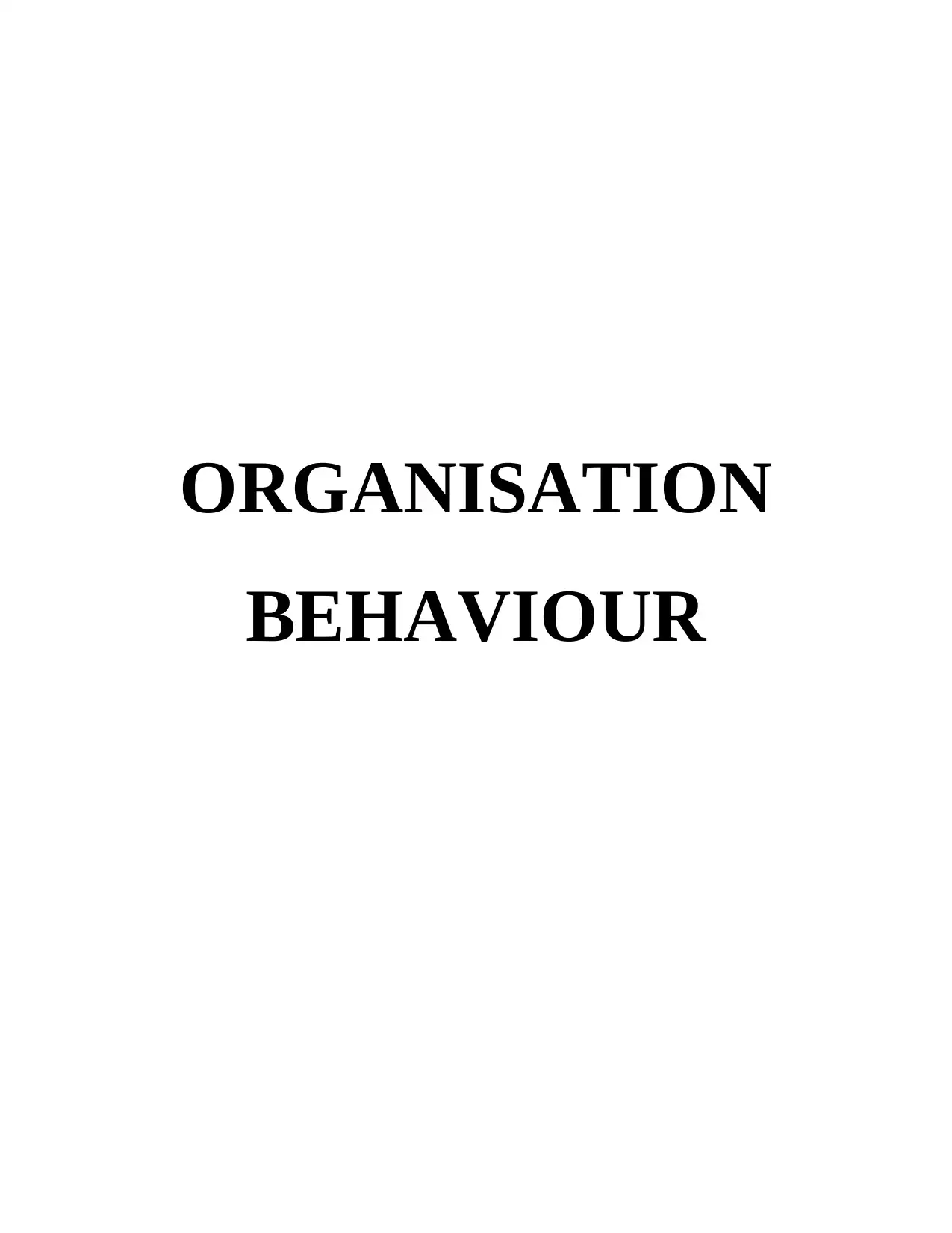
ORGANISATION
BEHAVIOUR
BEHAVIOUR
Secure Best Marks with AI Grader
Need help grading? Try our AI Grader for instant feedback on your assignments.
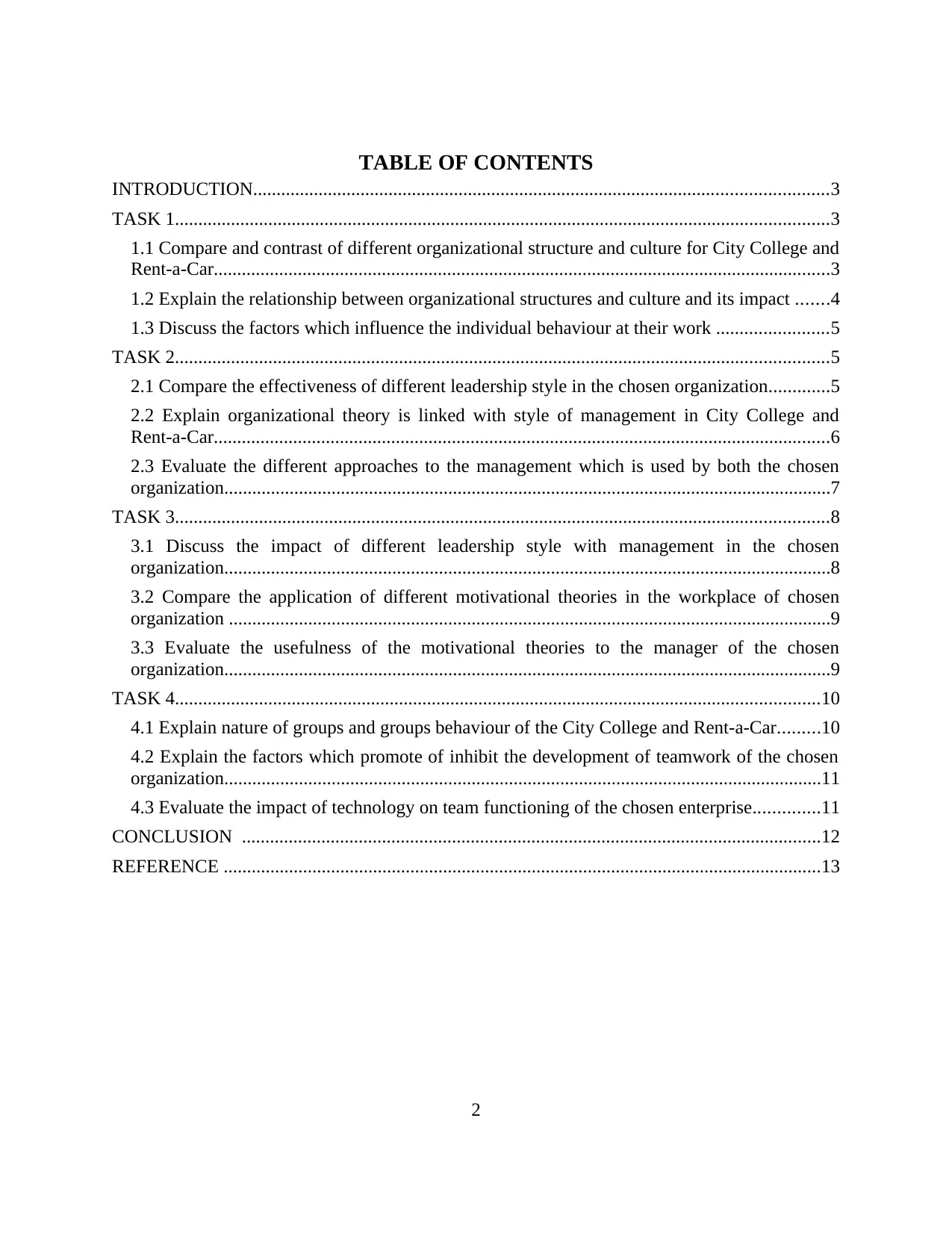
TABLE OF CONTENTS
INTRODUCTION...........................................................................................................................3
TASK 1............................................................................................................................................3
1.1 Compare and contrast of different organizational structure and culture for City College and
Rent-a-Car....................................................................................................................................3
1.2 Explain the relationship between organizational structures and culture and its impact .......4
1.3 Discuss the factors which influence the individual behaviour at their work ........................5
TASK 2............................................................................................................................................5
2.1 Compare the effectiveness of different leadership style in the chosen organization.............5
2.2 Explain organizational theory is linked with style of management in City College and
Rent-a-Car....................................................................................................................................6
2.3 Evaluate the different approaches to the management which is used by both the chosen
organization..................................................................................................................................7
TASK 3............................................................................................................................................8
3.1 Discuss the impact of different leadership style with management in the chosen
organization..................................................................................................................................8
3.2 Compare the application of different motivational theories in the workplace of chosen
organization .................................................................................................................................9
3.3 Evaluate the usefulness of the motivational theories to the manager of the chosen
organization..................................................................................................................................9
TASK 4..........................................................................................................................................10
4.1 Explain nature of groups and groups behaviour of the City College and Rent-a-Car.........10
4.2 Explain the factors which promote of inhibit the development of teamwork of the chosen
organization................................................................................................................................11
4.3 Evaluate the impact of technology on team functioning of the chosen enterprise..............11
CONCLUSION ............................................................................................................................12
REFERENCE ................................................................................................................................13
2
INTRODUCTION...........................................................................................................................3
TASK 1............................................................................................................................................3
1.1 Compare and contrast of different organizational structure and culture for City College and
Rent-a-Car....................................................................................................................................3
1.2 Explain the relationship between organizational structures and culture and its impact .......4
1.3 Discuss the factors which influence the individual behaviour at their work ........................5
TASK 2............................................................................................................................................5
2.1 Compare the effectiveness of different leadership style in the chosen organization.............5
2.2 Explain organizational theory is linked with style of management in City College and
Rent-a-Car....................................................................................................................................6
2.3 Evaluate the different approaches to the management which is used by both the chosen
organization..................................................................................................................................7
TASK 3............................................................................................................................................8
3.1 Discuss the impact of different leadership style with management in the chosen
organization..................................................................................................................................8
3.2 Compare the application of different motivational theories in the workplace of chosen
organization .................................................................................................................................9
3.3 Evaluate the usefulness of the motivational theories to the manager of the chosen
organization..................................................................................................................................9
TASK 4..........................................................................................................................................10
4.1 Explain nature of groups and groups behaviour of the City College and Rent-a-Car.........10
4.2 Explain the factors which promote of inhibit the development of teamwork of the chosen
organization................................................................................................................................11
4.3 Evaluate the impact of technology on team functioning of the chosen enterprise..............11
CONCLUSION ............................................................................................................................12
REFERENCE ................................................................................................................................13
2
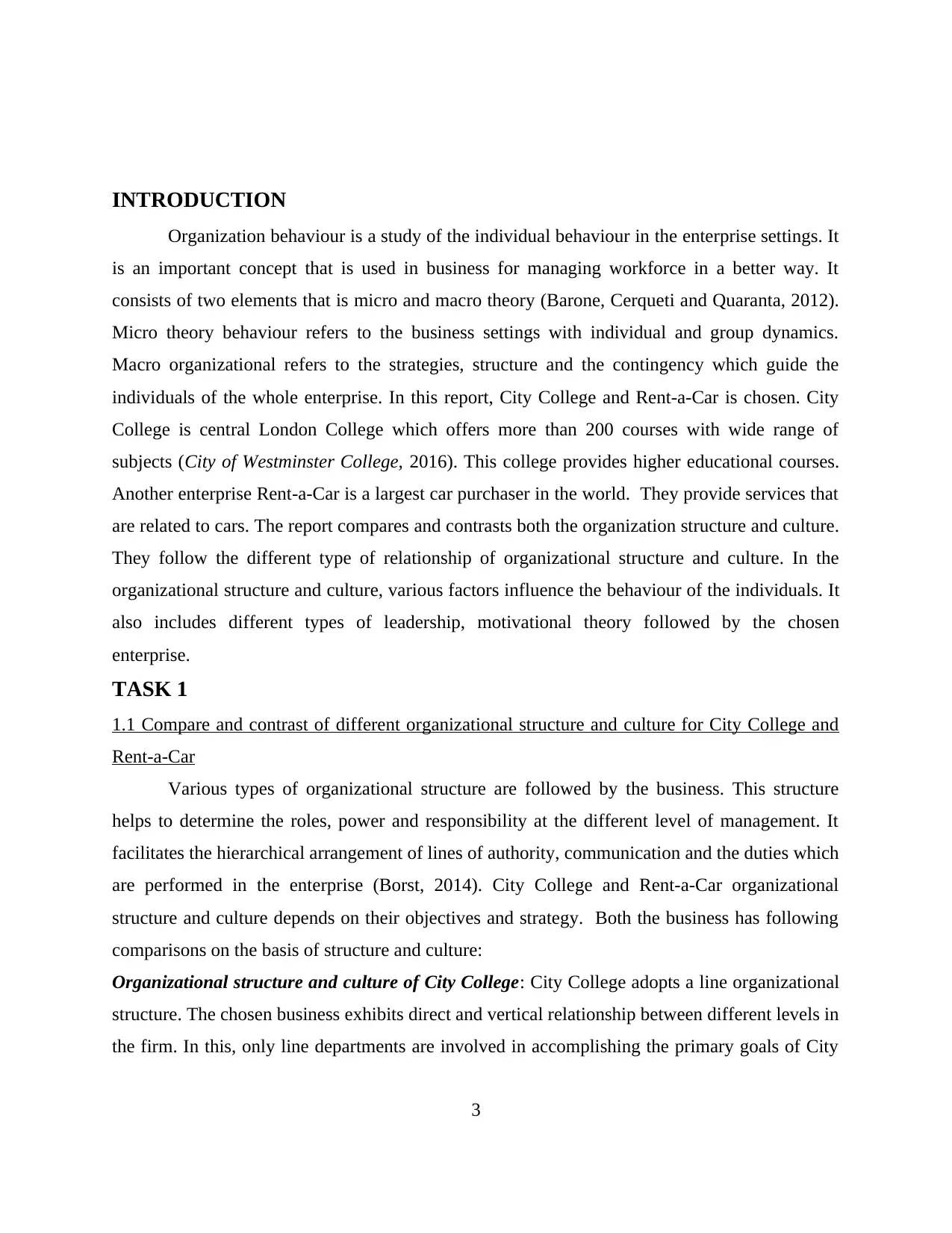
INTRODUCTION
Organization behaviour is a study of the individual behaviour in the enterprise settings. It
is an important concept that is used in business for managing workforce in a better way. It
consists of two elements that is micro and macro theory (Barone, Cerqueti and Quaranta, 2012).
Micro theory behaviour refers to the business settings with individual and group dynamics.
Macro organizational refers to the strategies, structure and the contingency which guide the
individuals of the whole enterprise. In this report, City College and Rent-a-Car is chosen. City
College is central London College which offers more than 200 courses with wide range of
subjects (City of Westminster College, 2016). This college provides higher educational courses.
Another enterprise Rent-a-Car is a largest car purchaser in the world. They provide services that
are related to cars. The report compares and contrasts both the organization structure and culture.
They follow the different type of relationship of organizational structure and culture. In the
organizational structure and culture, various factors influence the behaviour of the individuals. It
also includes different types of leadership, motivational theory followed by the chosen
enterprise.
TASK 1
1.1 Compare and contrast of different organizational structure and culture for City College and
Rent-a-Car
Various types of organizational structure are followed by the business. This structure
helps to determine the roles, power and responsibility at the different level of management. It
facilitates the hierarchical arrangement of lines of authority, communication and the duties which
are performed in the enterprise (Borst, 2014). City College and Rent-a-Car organizational
structure and culture depends on their objectives and strategy. Both the business has following
comparisons on the basis of structure and culture:
Organizational structure and culture of City College: City College adopts a line organizational
structure. The chosen business exhibits direct and vertical relationship between different levels in
the firm. In this, only line departments are involved in accomplishing the primary goals of City
3
Organization behaviour is a study of the individual behaviour in the enterprise settings. It
is an important concept that is used in business for managing workforce in a better way. It
consists of two elements that is micro and macro theory (Barone, Cerqueti and Quaranta, 2012).
Micro theory behaviour refers to the business settings with individual and group dynamics.
Macro organizational refers to the strategies, structure and the contingency which guide the
individuals of the whole enterprise. In this report, City College and Rent-a-Car is chosen. City
College is central London College which offers more than 200 courses with wide range of
subjects (City of Westminster College, 2016). This college provides higher educational courses.
Another enterprise Rent-a-Car is a largest car purchaser in the world. They provide services that
are related to cars. The report compares and contrasts both the organization structure and culture.
They follow the different type of relationship of organizational structure and culture. In the
organizational structure and culture, various factors influence the behaviour of the individuals. It
also includes different types of leadership, motivational theory followed by the chosen
enterprise.
TASK 1
1.1 Compare and contrast of different organizational structure and culture for City College and
Rent-a-Car
Various types of organizational structure are followed by the business. This structure
helps to determine the roles, power and responsibility at the different level of management. It
facilitates the hierarchical arrangement of lines of authority, communication and the duties which
are performed in the enterprise (Borst, 2014). City College and Rent-a-Car organizational
structure and culture depends on their objectives and strategy. Both the business has following
comparisons on the basis of structure and culture:
Organizational structure and culture of City College: City College adopts a line organizational
structure. The chosen business exhibits direct and vertical relationship between different levels in
the firm. In this, only line departments are involved in accomplishing the primary goals of City
3
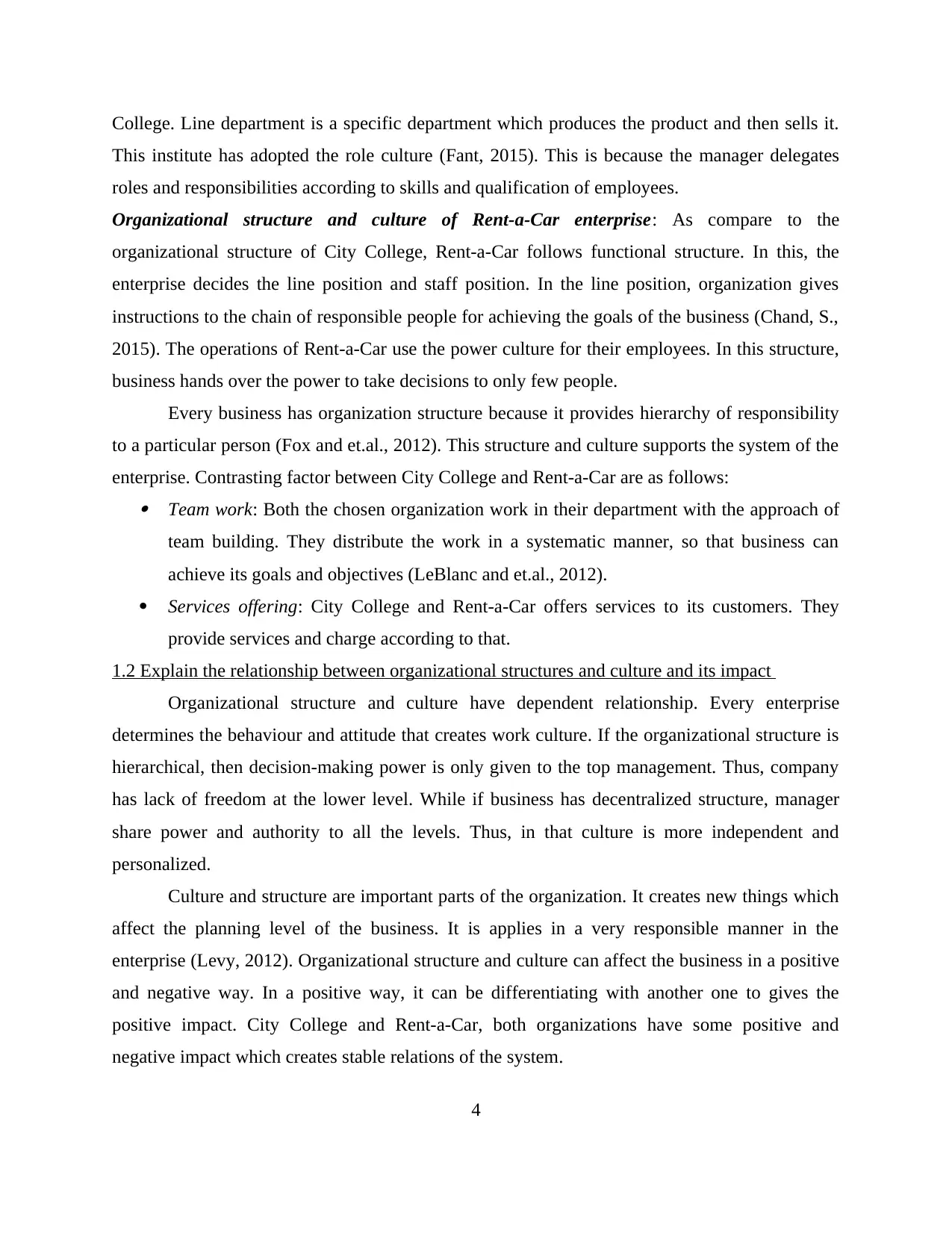
College. Line department is a specific department which produces the product and then sells it.
This institute has adopted the role culture (Fant, 2015). This is because the manager delegates
roles and responsibilities according to skills and qualification of employees.
Organizational structure and culture of Rent-a-Car enterprise: As compare to the
organizational structure of City College, Rent-a-Car follows functional structure. In this, the
enterprise decides the line position and staff position. In the line position, organization gives
instructions to the chain of responsible people for achieving the goals of the business (Chand, S.,
2015). The operations of Rent-a-Car use the power culture for their employees. In this structure,
business hands over the power to take decisions to only few people.
Every business has organization structure because it provides hierarchy of responsibility
to a particular person (Fox and et.al., 2012). This structure and culture supports the system of the
enterprise. Contrasting factor between City College and Rent-a-Car are as follows: Team work: Both the chosen organization work in their department with the approach of
team building. They distribute the work in a systematic manner, so that business can
achieve its goals and objectives (LeBlanc and et.al., 2012).
Services offering: City College and Rent-a-Car offers services to its customers. They
provide services and charge according to that.
1.2 Explain the relationship between organizational structures and culture and its impact
Organizational structure and culture have dependent relationship. Every enterprise
determines the behaviour and attitude that creates work culture. If the organizational structure is
hierarchical, then decision-making power is only given to the top management. Thus, company
has lack of freedom at the lower level. While if business has decentralized structure, manager
share power and authority to all the levels. Thus, in that culture is more independent and
personalized.
Culture and structure are important parts of the organization. It creates new things which
affect the planning level of the business. It is applies in a very responsible manner in the
enterprise (Levy, 2012). Organizational structure and culture can affect the business in a positive
and negative way. In a positive way, it can be differentiating with another one to gives the
positive impact. City College and Rent-a-Car, both organizations have some positive and
negative impact which creates stable relations of the system.
4
This institute has adopted the role culture (Fant, 2015). This is because the manager delegates
roles and responsibilities according to skills and qualification of employees.
Organizational structure and culture of Rent-a-Car enterprise: As compare to the
organizational structure of City College, Rent-a-Car follows functional structure. In this, the
enterprise decides the line position and staff position. In the line position, organization gives
instructions to the chain of responsible people for achieving the goals of the business (Chand, S.,
2015). The operations of Rent-a-Car use the power culture for their employees. In this structure,
business hands over the power to take decisions to only few people.
Every business has organization structure because it provides hierarchy of responsibility
to a particular person (Fox and et.al., 2012). This structure and culture supports the system of the
enterprise. Contrasting factor between City College and Rent-a-Car are as follows: Team work: Both the chosen organization work in their department with the approach of
team building. They distribute the work in a systematic manner, so that business can
achieve its goals and objectives (LeBlanc and et.al., 2012).
Services offering: City College and Rent-a-Car offers services to its customers. They
provide services and charge according to that.
1.2 Explain the relationship between organizational structures and culture and its impact
Organizational structure and culture have dependent relationship. Every enterprise
determines the behaviour and attitude that creates work culture. If the organizational structure is
hierarchical, then decision-making power is only given to the top management. Thus, company
has lack of freedom at the lower level. While if business has decentralized structure, manager
share power and authority to all the levels. Thus, in that culture is more independent and
personalized.
Culture and structure are important parts of the organization. It creates new things which
affect the planning level of the business. It is applies in a very responsible manner in the
enterprise (Levy, 2012). Organizational structure and culture can affect the business in a positive
and negative way. In a positive way, it can be differentiating with another one to gives the
positive impact. City College and Rent-a-Car, both organizations have some positive and
negative impact which creates stable relations of the system.
4
Secure Best Marks with AI Grader
Need help grading? Try our AI Grader for instant feedback on your assignments.

Organizational structure and culture brings the stability with the social system in the
company. It is more complex to the decision-making in the business. This is because many of
systems are based on the structure and culture of the enterprise (Lin and et.al., 2012).
1.3 Discuss the factors which influence the individual behaviour at their work
In order to evaluate human factors, it is important to understand the settings, capabilities
and limitations of the company (Maclean, Harvey and Chia, 2012). Modern working
environment is different for every person. The following are the factors which influence the
individual behaviour in the chosen organization at their work:
Leadership: Mangers and leaders must play an important role in influencing the
behaviour of individual at their work. Leadership style is different for every leader.
Thus, it can impact the individual of City College and Rent-a-Car. This is because every
leader provides direction by adopting different method (Nwankwo and et.al., 2013).
Work culture: Every individual wants comfort at the workplace. It helps to stay positive
and happily at the organization. Rules and regulations are same for every member of the
company. Transparency is essential of every level for both the chosen enterprise. Work
culture can influence behaviour of an individual if the business provides them
appropriate workplace (Nwibere, 2014).
Effective communication: Manager has the duty to communicate effectively with their
team members. If he does not effectively communicate with employees then the workers
can lose their interest in their work. Hence, Effective communication impacts the
behaviour of individual. So it is essential for both cited organization to communicate
with their employees. It can influence individual behaviour as when they are
communicating in an effective manner, it makes the work easier and generates interest of
individual (Factors Affecting Employee Behaviour. 2016).
TASK 2
2.1 Compare the effectiveness of different leadership style in the chosen organization
Leadership style plays an important role in small business as well as in the large
enterprise. It has direct cause and effect relationship. Leaders can determine their values, culture
etc. towards their leadership style (Paillé, 2013). The chosen organizations follow the following
leadership style:
5
company. It is more complex to the decision-making in the business. This is because many of
systems are based on the structure and culture of the enterprise (Lin and et.al., 2012).
1.3 Discuss the factors which influence the individual behaviour at their work
In order to evaluate human factors, it is important to understand the settings, capabilities
and limitations of the company (Maclean, Harvey and Chia, 2012). Modern working
environment is different for every person. The following are the factors which influence the
individual behaviour in the chosen organization at their work:
Leadership: Mangers and leaders must play an important role in influencing the
behaviour of individual at their work. Leadership style is different for every leader.
Thus, it can impact the individual of City College and Rent-a-Car. This is because every
leader provides direction by adopting different method (Nwankwo and et.al., 2013).
Work culture: Every individual wants comfort at the workplace. It helps to stay positive
and happily at the organization. Rules and regulations are same for every member of the
company. Transparency is essential of every level for both the chosen enterprise. Work
culture can influence behaviour of an individual if the business provides them
appropriate workplace (Nwibere, 2014).
Effective communication: Manager has the duty to communicate effectively with their
team members. If he does not effectively communicate with employees then the workers
can lose their interest in their work. Hence, Effective communication impacts the
behaviour of individual. So it is essential for both cited organization to communicate
with their employees. It can influence individual behaviour as when they are
communicating in an effective manner, it makes the work easier and generates interest of
individual (Factors Affecting Employee Behaviour. 2016).
TASK 2
2.1 Compare the effectiveness of different leadership style in the chosen organization
Leadership style plays an important role in small business as well as in the large
enterprise. It has direct cause and effect relationship. Leaders can determine their values, culture
etc. towards their leadership style (Paillé, 2013). The chosen organizations follow the following
leadership style:
5
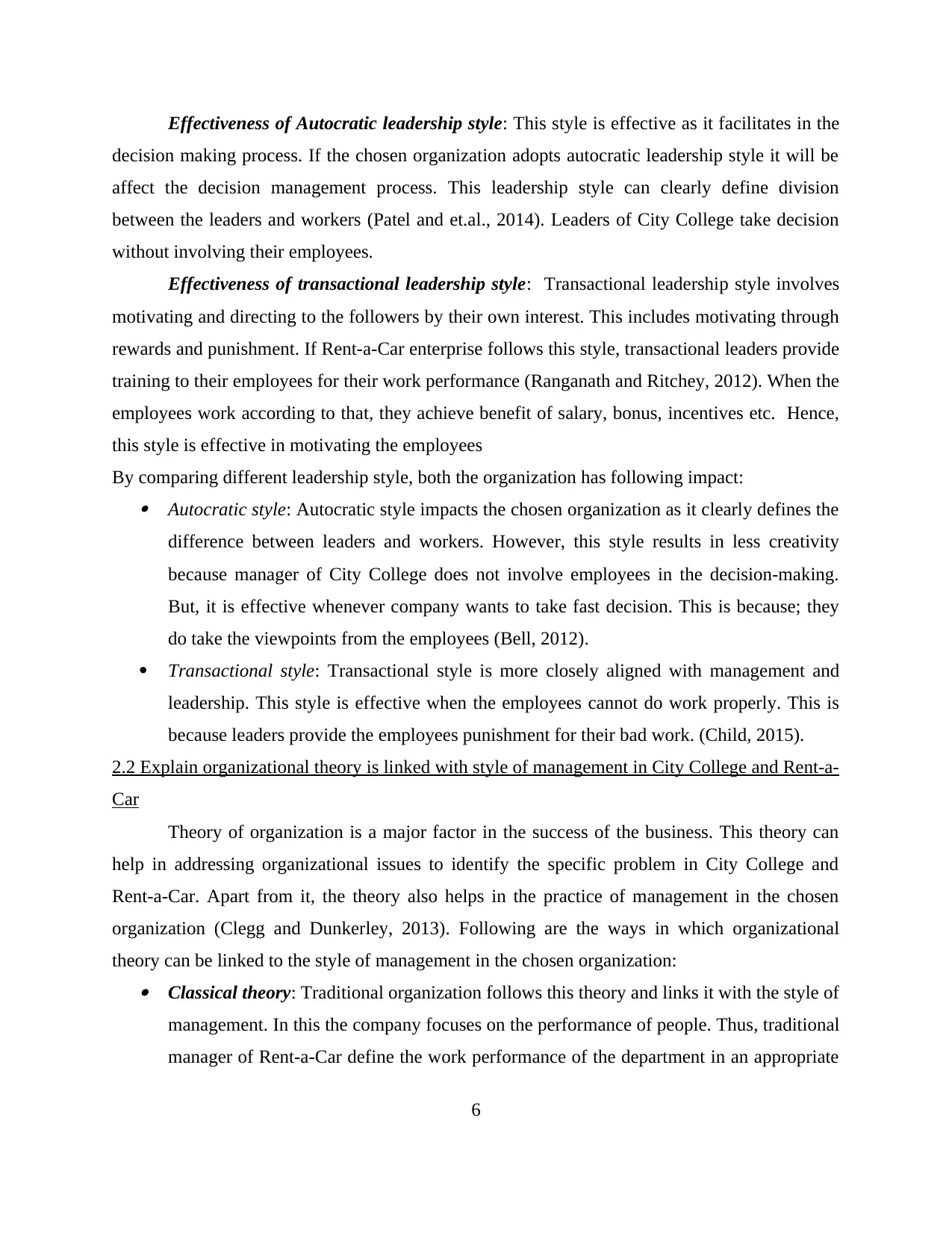
Effectiveness of Autocratic leadership style: This style is effective as it facilitates in the
decision making process. If the chosen organization adopts autocratic leadership style it will be
affect the decision management process. This leadership style can clearly define division
between the leaders and workers (Patel and et.al., 2014). Leaders of City College take decision
without involving their employees.
Effectiveness of transactional leadership style: Transactional leadership style involves
motivating and directing to the followers by their own interest. This includes motivating through
rewards and punishment. If Rent-a-Car enterprise follows this style, transactional leaders provide
training to their employees for their work performance (Ranganath and Ritchey, 2012). When the
employees work according to that, they achieve benefit of salary, bonus, incentives etc. Hence,
this style is effective in motivating the employees
By comparing different leadership style, both the organization has following impact: Autocratic style: Autocratic style impacts the chosen organization as it clearly defines the
difference between leaders and workers. However, this style results in less creativity
because manager of City College does not involve employees in the decision-making.
But, it is effective whenever company wants to take fast decision. This is because; they
do take the viewpoints from the employees (Bell, 2012).
Transactional style: Transactional style is more closely aligned with management and
leadership. This style is effective when the employees cannot do work properly. This is
because leaders provide the employees punishment for their bad work. (Child, 2015).
2.2 Explain organizational theory is linked with style of management in City College and Rent-a-
Car
Theory of organization is a major factor in the success of the business. This theory can
help in addressing organizational issues to identify the specific problem in City College and
Rent-a-Car. Apart from it, the theory also helps in the practice of management in the chosen
organization (Clegg and Dunkerley, 2013). Following are the ways in which organizational
theory can be linked to the style of management in the chosen organization: Classical theory: Traditional organization follows this theory and links it with the style of
management. In this the company focuses on the performance of people. Thus, traditional
manager of Rent-a-Car define the work performance of the department in an appropriate
6
decision making process. If the chosen organization adopts autocratic leadership style it will be
affect the decision management process. This leadership style can clearly define division
between the leaders and workers (Patel and et.al., 2014). Leaders of City College take decision
without involving their employees.
Effectiveness of transactional leadership style: Transactional leadership style involves
motivating and directing to the followers by their own interest. This includes motivating through
rewards and punishment. If Rent-a-Car enterprise follows this style, transactional leaders provide
training to their employees for their work performance (Ranganath and Ritchey, 2012). When the
employees work according to that, they achieve benefit of salary, bonus, incentives etc. Hence,
this style is effective in motivating the employees
By comparing different leadership style, both the organization has following impact: Autocratic style: Autocratic style impacts the chosen organization as it clearly defines the
difference between leaders and workers. However, this style results in less creativity
because manager of City College does not involve employees in the decision-making.
But, it is effective whenever company wants to take fast decision. This is because; they
do take the viewpoints from the employees (Bell, 2012).
Transactional style: Transactional style is more closely aligned with management and
leadership. This style is effective when the employees cannot do work properly. This is
because leaders provide the employees punishment for their bad work. (Child, 2015).
2.2 Explain organizational theory is linked with style of management in City College and Rent-a-
Car
Theory of organization is a major factor in the success of the business. This theory can
help in addressing organizational issues to identify the specific problem in City College and
Rent-a-Car. Apart from it, the theory also helps in the practice of management in the chosen
organization (Clegg and Dunkerley, 2013). Following are the ways in which organizational
theory can be linked to the style of management in the chosen organization: Classical theory: Traditional organization follows this theory and links it with the style of
management. In this the company focuses on the performance of people. Thus, traditional
manager of Rent-a-Car define the work performance of the department in an appropriate
6
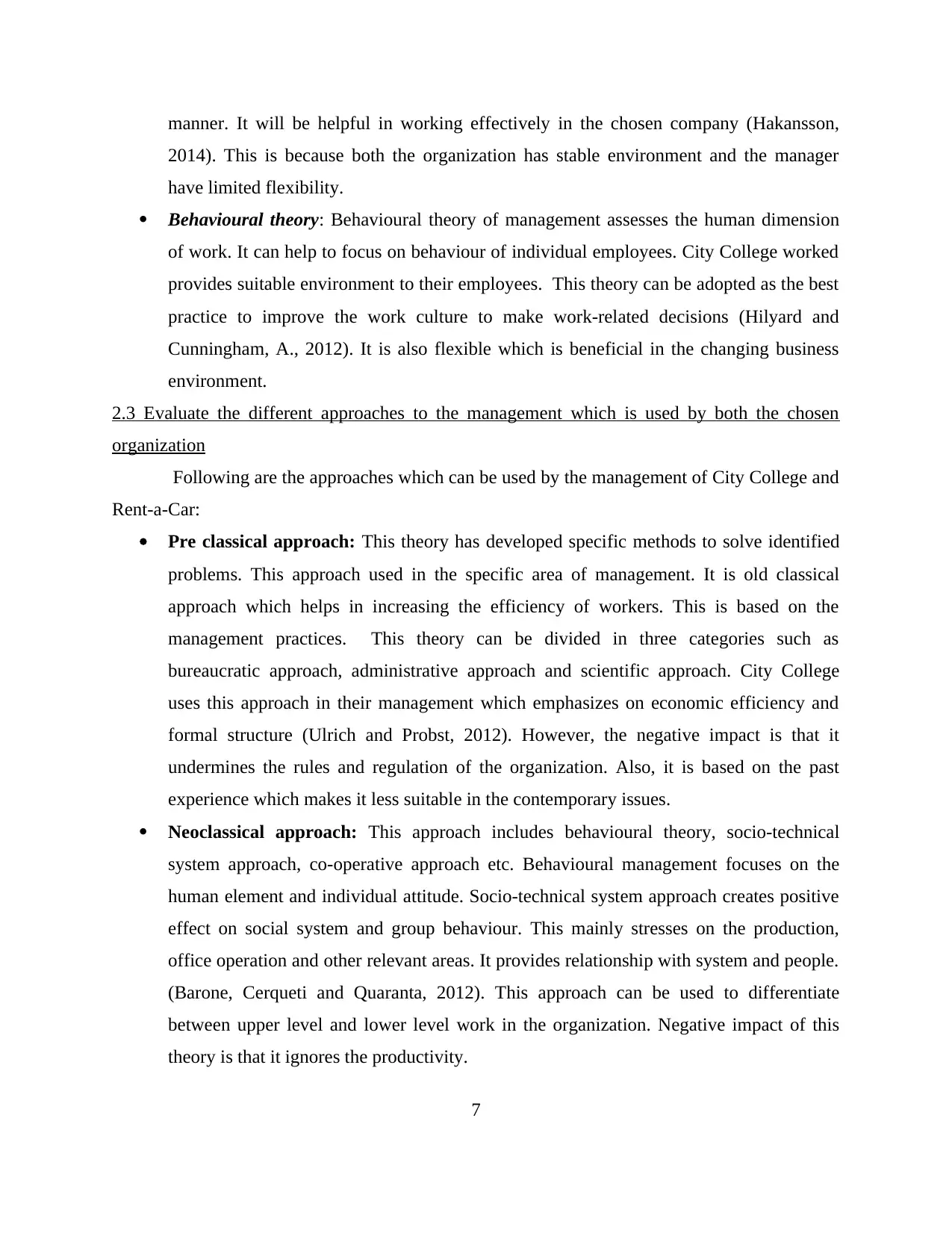
manner. It will be helpful in working effectively in the chosen company (Hakansson,
2014). This is because both the organization has stable environment and the manager
have limited flexibility.
Behavioural theory: Behavioural theory of management assesses the human dimension
of work. It can help to focus on behaviour of individual employees. City College worked
provides suitable environment to their employees. This theory can be adopted as the best
practice to improve the work culture to make work-related decisions (Hilyard and
Cunningham, A., 2012). It is also flexible which is beneficial in the changing business
environment.
2.3 Evaluate the different approaches to the management which is used by both the chosen
organization
Following are the approaches which can be used by the management of City College and
Rent-a-Car:
Pre classical approach: This theory has developed specific methods to solve identified
problems. This approach used in the specific area of management. It is old classical
approach which helps in increasing the efficiency of workers. This is based on the
management practices. This theory can be divided in three categories such as
bureaucratic approach, administrative approach and scientific approach. City College
uses this approach in their management which emphasizes on economic efficiency and
formal structure (Ulrich and Probst, 2012). However, the negative impact is that it
undermines the rules and regulation of the organization. Also, it is based on the past
experience which makes it less suitable in the contemporary issues.
Neoclassical approach: This approach includes behavioural theory, socio-technical
system approach, co-operative approach etc. Behavioural management focuses on the
human element and individual attitude. Socio-technical system approach creates positive
effect on social system and group behaviour. This mainly stresses on the production,
office operation and other relevant areas. It provides relationship with system and people.
(Barone, Cerqueti and Quaranta, 2012). This approach can be used to differentiate
between upper level and lower level work in the organization. Negative impact of this
theory is that it ignores the productivity.
7
2014). This is because both the organization has stable environment and the manager
have limited flexibility.
Behavioural theory: Behavioural theory of management assesses the human dimension
of work. It can help to focus on behaviour of individual employees. City College worked
provides suitable environment to their employees. This theory can be adopted as the best
practice to improve the work culture to make work-related decisions (Hilyard and
Cunningham, A., 2012). It is also flexible which is beneficial in the changing business
environment.
2.3 Evaluate the different approaches to the management which is used by both the chosen
organization
Following are the approaches which can be used by the management of City College and
Rent-a-Car:
Pre classical approach: This theory has developed specific methods to solve identified
problems. This approach used in the specific area of management. It is old classical
approach which helps in increasing the efficiency of workers. This is based on the
management practices. This theory can be divided in three categories such as
bureaucratic approach, administrative approach and scientific approach. City College
uses this approach in their management which emphasizes on economic efficiency and
formal structure (Ulrich and Probst, 2012). However, the negative impact is that it
undermines the rules and regulation of the organization. Also, it is based on the past
experience which makes it less suitable in the contemporary issues.
Neoclassical approach: This approach includes behavioural theory, socio-technical
system approach, co-operative approach etc. Behavioural management focuses on the
human element and individual attitude. Socio-technical system approach creates positive
effect on social system and group behaviour. This mainly stresses on the production,
office operation and other relevant areas. It provides relationship with system and people.
(Barone, Cerqueti and Quaranta, 2012). This approach can be used to differentiate
between upper level and lower level work in the organization. Negative impact of this
theory is that it ignores the productivity.
7
Paraphrase This Document
Need a fresh take? Get an instant paraphrase of this document with our AI Paraphraser
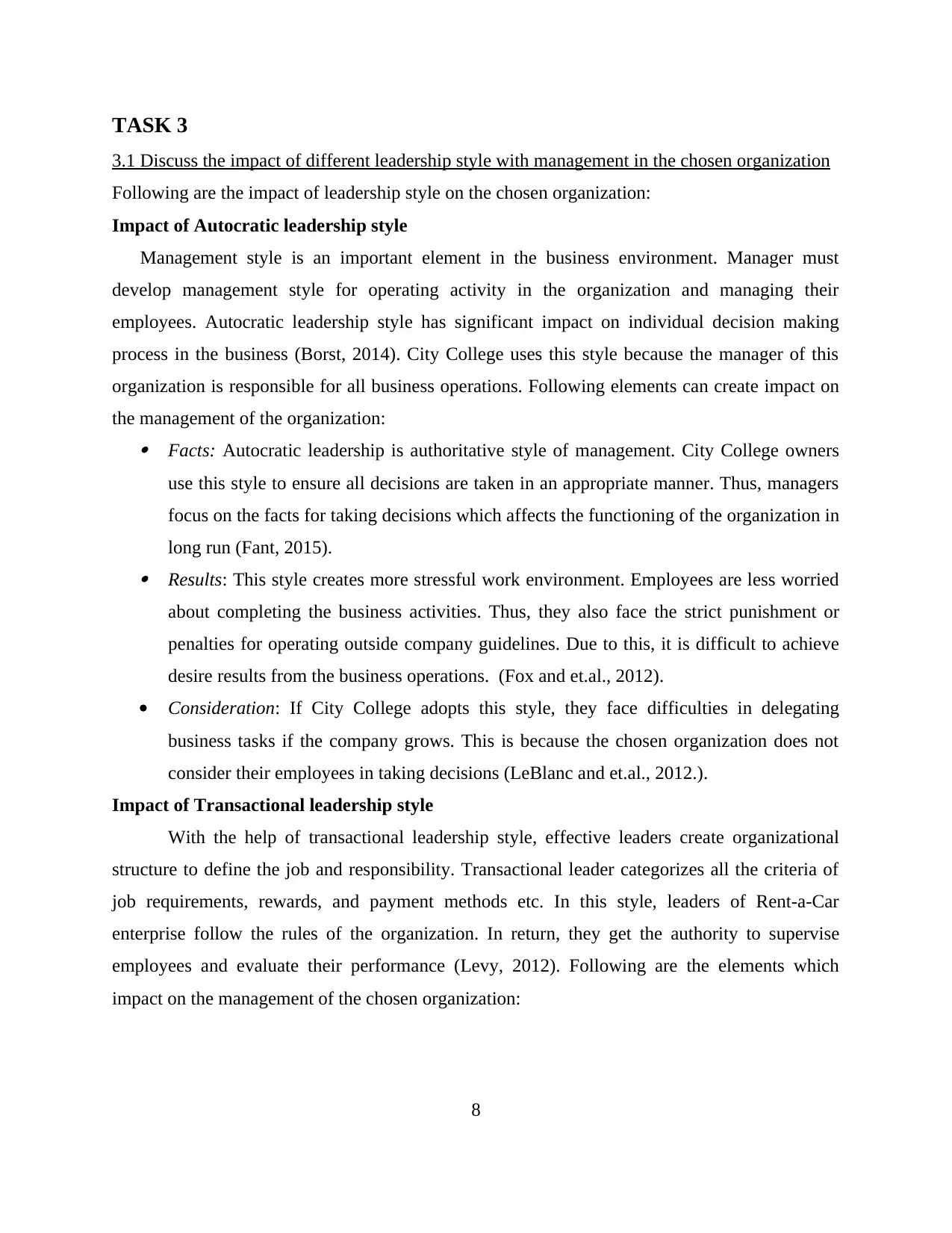
TASK 3
3.1 Discuss the impact of different leadership style with management in the chosen organization
Following are the impact of leadership style on the chosen organization:
Impact of Autocratic leadership style
Management style is an important element in the business environment. Manager must
develop management style for operating activity in the organization and managing their
employees. Autocratic leadership style has significant impact on individual decision making
process in the business (Borst, 2014). City College uses this style because the manager of this
organization is responsible for all business operations. Following elements can create impact on
the management of the organization: Facts: Autocratic leadership is authoritative style of management. City College owners
use this style to ensure all decisions are taken in an appropriate manner. Thus, managers
focus on the facts for taking decisions which affects the functioning of the organization in
long run (Fant, 2015). Results: This style creates more stressful work environment. Employees are less worried
about completing the business activities. Thus, they also face the strict punishment or
penalties for operating outside company guidelines. Due to this, it is difficult to achieve
desire results from the business operations. (Fox and et.al., 2012).
Consideration: If City College adopts this style, they face difficulties in delegating
business tasks if the company grows. This is because the chosen organization does not
consider their employees in taking decisions (LeBlanc and et.al., 2012.).
Impact of Transactional leadership style
With the help of transactional leadership style, effective leaders create organizational
structure to define the job and responsibility. Transactional leader categorizes all the criteria of
job requirements, rewards, and payment methods etc. In this style, leaders of Rent-a-Car
enterprise follow the rules of the organization. In return, they get the authority to supervise
employees and evaluate their performance (Levy, 2012). Following are the elements which
impact on the management of the chosen organization:
8
3.1 Discuss the impact of different leadership style with management in the chosen organization
Following are the impact of leadership style on the chosen organization:
Impact of Autocratic leadership style
Management style is an important element in the business environment. Manager must
develop management style for operating activity in the organization and managing their
employees. Autocratic leadership style has significant impact on individual decision making
process in the business (Borst, 2014). City College uses this style because the manager of this
organization is responsible for all business operations. Following elements can create impact on
the management of the organization: Facts: Autocratic leadership is authoritative style of management. City College owners
use this style to ensure all decisions are taken in an appropriate manner. Thus, managers
focus on the facts for taking decisions which affects the functioning of the organization in
long run (Fant, 2015). Results: This style creates more stressful work environment. Employees are less worried
about completing the business activities. Thus, they also face the strict punishment or
penalties for operating outside company guidelines. Due to this, it is difficult to achieve
desire results from the business operations. (Fox and et.al., 2012).
Consideration: If City College adopts this style, they face difficulties in delegating
business tasks if the company grows. This is because the chosen organization does not
consider their employees in taking decisions (LeBlanc and et.al., 2012.).
Impact of Transactional leadership style
With the help of transactional leadership style, effective leaders create organizational
structure to define the job and responsibility. Transactional leader categorizes all the criteria of
job requirements, rewards, and payment methods etc. In this style, leaders of Rent-a-Car
enterprise follow the rules of the organization. In return, they get the authority to supervise
employees and evaluate their performance (Levy, 2012). Following are the elements which
impact on the management of the chosen organization:
8
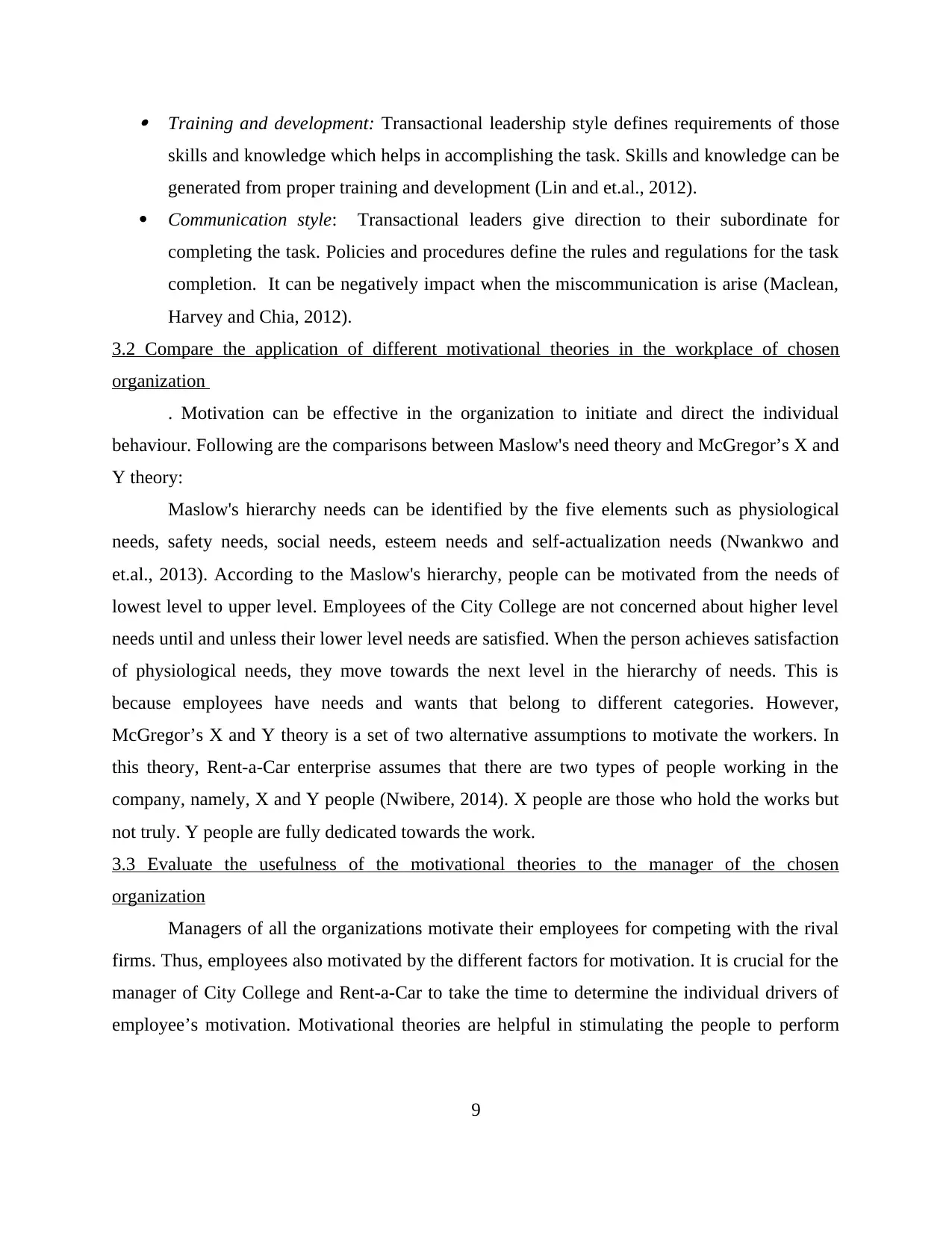
Training and development: Transactional leadership style defines requirements of those
skills and knowledge which helps in accomplishing the task. Skills and knowledge can be
generated from proper training and development (Lin and et.al., 2012).
Communication style: Transactional leaders give direction to their subordinate for
completing the task. Policies and procedures define the rules and regulations for the task
completion. It can be negatively impact when the miscommunication is arise (Maclean,
Harvey and Chia, 2012).
3.2 Compare the application of different motivational theories in the workplace of chosen
organization
. Motivation can be effective in the organization to initiate and direct the individual
behaviour. Following are the comparisons between Maslow's need theory and McGregor’s X and
Y theory:
Maslow's hierarchy needs can be identified by the five elements such as physiological
needs, safety needs, social needs, esteem needs and self-actualization needs (Nwankwo and
et.al., 2013). According to the Maslow's hierarchy, people can be motivated from the needs of
lowest level to upper level. Employees of the City College are not concerned about higher level
needs until and unless their lower level needs are satisfied. When the person achieves satisfaction
of physiological needs, they move towards the next level in the hierarchy of needs. This is
because employees have needs and wants that belong to different categories. However,
McGregor’s X and Y theory is a set of two alternative assumptions to motivate the workers. In
this theory, Rent-a-Car enterprise assumes that there are two types of people working in the
company, namely, X and Y people (Nwibere, 2014). X people are those who hold the works but
not truly. Y people are fully dedicated towards the work.
3.3 Evaluate the usefulness of the motivational theories to the manager of the chosen
organization
Managers of all the organizations motivate their employees for competing with the rival
firms. Thus, employees also motivated by the different factors for motivation. It is crucial for the
manager of City College and Rent-a-Car to take the time to determine the individual drivers of
employee’s motivation. Motivational theories are helpful in stimulating the people to perform
9
skills and knowledge which helps in accomplishing the task. Skills and knowledge can be
generated from proper training and development (Lin and et.al., 2012).
Communication style: Transactional leaders give direction to their subordinate for
completing the task. Policies and procedures define the rules and regulations for the task
completion. It can be negatively impact when the miscommunication is arise (Maclean,
Harvey and Chia, 2012).
3.2 Compare the application of different motivational theories in the workplace of chosen
organization
. Motivation can be effective in the organization to initiate and direct the individual
behaviour. Following are the comparisons between Maslow's need theory and McGregor’s X and
Y theory:
Maslow's hierarchy needs can be identified by the five elements such as physiological
needs, safety needs, social needs, esteem needs and self-actualization needs (Nwankwo and
et.al., 2013). According to the Maslow's hierarchy, people can be motivated from the needs of
lowest level to upper level. Employees of the City College are not concerned about higher level
needs until and unless their lower level needs are satisfied. When the person achieves satisfaction
of physiological needs, they move towards the next level in the hierarchy of needs. This is
because employees have needs and wants that belong to different categories. However,
McGregor’s X and Y theory is a set of two alternative assumptions to motivate the workers. In
this theory, Rent-a-Car enterprise assumes that there are two types of people working in the
company, namely, X and Y people (Nwibere, 2014). X people are those who hold the works but
not truly. Y people are fully dedicated towards the work.
3.3 Evaluate the usefulness of the motivational theories to the manager of the chosen
organization
Managers of all the organizations motivate their employees for competing with the rival
firms. Thus, employees also motivated by the different factors for motivation. It is crucial for the
manager of City College and Rent-a-Car to take the time to determine the individual drivers of
employee’s motivation. Motivational theories are helpful in stimulating the people to perform
9
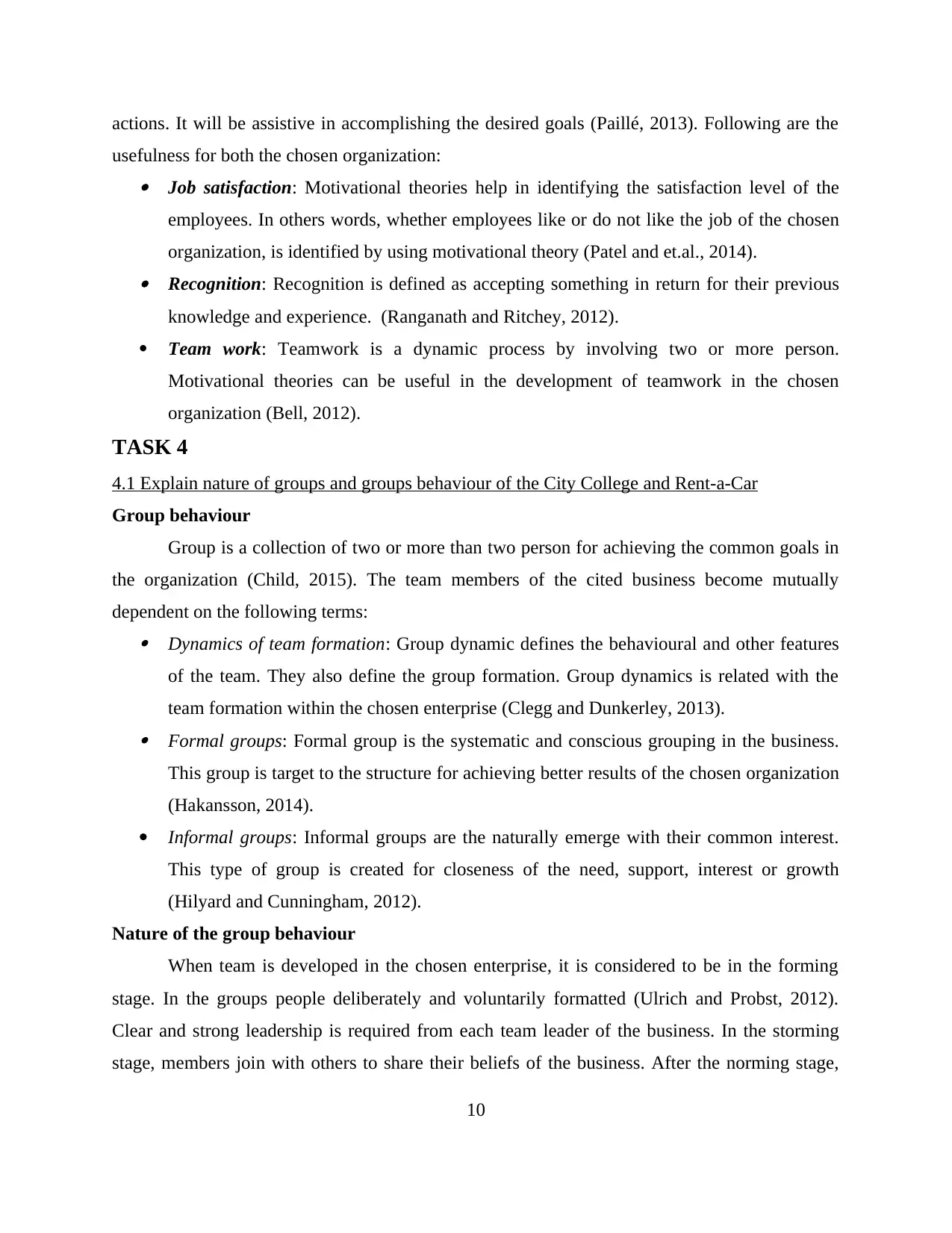
actions. It will be assistive in accomplishing the desired goals (Paillé, 2013). Following are the
usefulness for both the chosen organization: Job satisfaction: Motivational theories help in identifying the satisfaction level of the
employees. In others words, whether employees like or do not like the job of the chosen
organization, is identified by using motivational theory (Patel and et.al., 2014). Recognition: Recognition is defined as accepting something in return for their previous
knowledge and experience. (Ranganath and Ritchey, 2012).
Team work: Teamwork is a dynamic process by involving two or more person.
Motivational theories can be useful in the development of teamwork in the chosen
organization (Bell, 2012).
TASK 4
4.1 Explain nature of groups and groups behaviour of the City College and Rent-a-Car
Group behaviour
Group is a collection of two or more than two person for achieving the common goals in
the organization (Child, 2015). The team members of the cited business become mutually
dependent on the following terms: Dynamics of team formation: Group dynamic defines the behavioural and other features
of the team. They also define the group formation. Group dynamics is related with the
team formation within the chosen enterprise (Clegg and Dunkerley, 2013). Formal groups: Formal group is the systematic and conscious grouping in the business.
This group is target to the structure for achieving better results of the chosen organization
(Hakansson, 2014).
Informal groups: Informal groups are the naturally emerge with their common interest.
This type of group is created for closeness of the need, support, interest or growth
(Hilyard and Cunningham, 2012).
Nature of the group behaviour
When team is developed in the chosen enterprise, it is considered to be in the forming
stage. In the groups people deliberately and voluntarily formatted (Ulrich and Probst, 2012).
Clear and strong leadership is required from each team leader of the business. In the storming
stage, members join with others to share their beliefs of the business. After the norming stage,
10
usefulness for both the chosen organization: Job satisfaction: Motivational theories help in identifying the satisfaction level of the
employees. In others words, whether employees like or do not like the job of the chosen
organization, is identified by using motivational theory (Patel and et.al., 2014). Recognition: Recognition is defined as accepting something in return for their previous
knowledge and experience. (Ranganath and Ritchey, 2012).
Team work: Teamwork is a dynamic process by involving two or more person.
Motivational theories can be useful in the development of teamwork in the chosen
organization (Bell, 2012).
TASK 4
4.1 Explain nature of groups and groups behaviour of the City College and Rent-a-Car
Group behaviour
Group is a collection of two or more than two person for achieving the common goals in
the organization (Child, 2015). The team members of the cited business become mutually
dependent on the following terms: Dynamics of team formation: Group dynamic defines the behavioural and other features
of the team. They also define the group formation. Group dynamics is related with the
team formation within the chosen enterprise (Clegg and Dunkerley, 2013). Formal groups: Formal group is the systematic and conscious grouping in the business.
This group is target to the structure for achieving better results of the chosen organization
(Hakansson, 2014).
Informal groups: Informal groups are the naturally emerge with their common interest.
This type of group is created for closeness of the need, support, interest or growth
(Hilyard and Cunningham, 2012).
Nature of the group behaviour
When team is developed in the chosen enterprise, it is considered to be in the forming
stage. In the groups people deliberately and voluntarily formatted (Ulrich and Probst, 2012).
Clear and strong leadership is required from each team leader of the business. In the storming
stage, members join with others to share their beliefs of the business. After the norming stage,
10
Secure Best Marks with AI Grader
Need help grading? Try our AI Grader for instant feedback on your assignments.
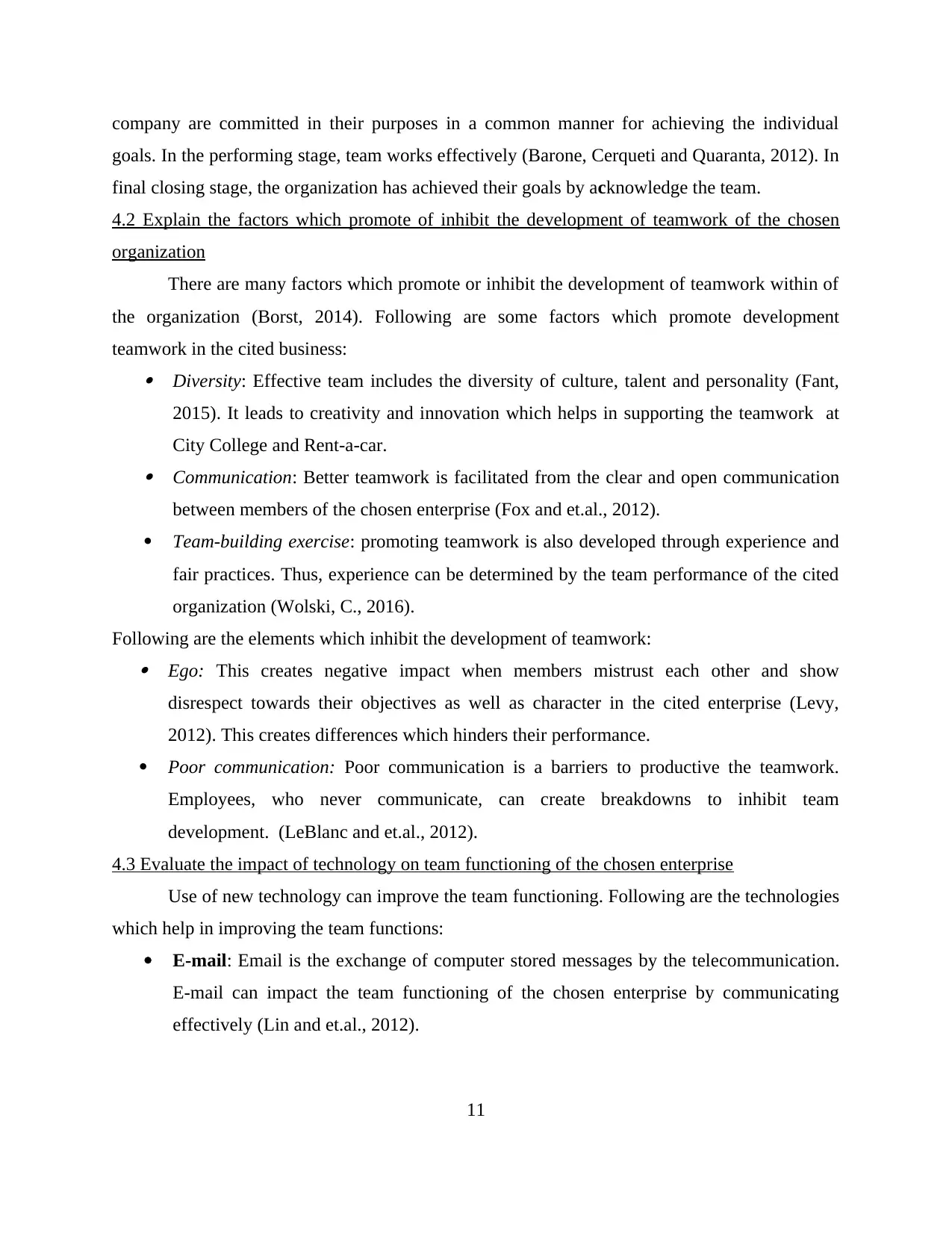
company are committed in their purposes in a common manner for achieving the individual
goals. In the performing stage, team works effectively (Barone, Cerqueti and Quaranta, 2012). In
final closing stage, the organization has achieved their goals by acknowledge the team.
4.2 Explain the factors which promote of inhibit the development of teamwork of the chosen
organization
There are many factors which promote or inhibit the development of teamwork within of
the organization (Borst, 2014). Following are some factors which promote development
teamwork in the cited business: Diversity: Effective team includes the diversity of culture, talent and personality (Fant,
2015). It leads to creativity and innovation which helps in supporting the teamwork at
City College and Rent-a-car. Communication: Better teamwork is facilitated from the clear and open communication
between members of the chosen enterprise (Fox and et.al., 2012).
Team-building exercise: promoting teamwork is also developed through experience and
fair practices. Thus, experience can be determined by the team performance of the cited
organization (Wolski, C., 2016).
Following are the elements which inhibit the development of teamwork: Ego: This creates negative impact when members mistrust each other and show
disrespect towards their objectives as well as character in the cited enterprise (Levy,
2012). This creates differences which hinders their performance.
Poor communication: Poor communication is a barriers to productive the teamwork.
Employees, who never communicate, can create breakdowns to inhibit team
development. (LeBlanc and et.al., 2012).
4.3 Evaluate the impact of technology on team functioning of the chosen enterprise
Use of new technology can improve the team functioning. Following are the technologies
which help in improving the team functions:
E-mail: Email is the exchange of computer stored messages by the telecommunication.
E-mail can impact the team functioning of the chosen enterprise by communicating
effectively (Lin and et.al., 2012).
11
goals. In the performing stage, team works effectively (Barone, Cerqueti and Quaranta, 2012). In
final closing stage, the organization has achieved their goals by acknowledge the team.
4.2 Explain the factors which promote of inhibit the development of teamwork of the chosen
organization
There are many factors which promote or inhibit the development of teamwork within of
the organization (Borst, 2014). Following are some factors which promote development
teamwork in the cited business: Diversity: Effective team includes the diversity of culture, talent and personality (Fant,
2015). It leads to creativity and innovation which helps in supporting the teamwork at
City College and Rent-a-car. Communication: Better teamwork is facilitated from the clear and open communication
between members of the chosen enterprise (Fox and et.al., 2012).
Team-building exercise: promoting teamwork is also developed through experience and
fair practices. Thus, experience can be determined by the team performance of the cited
organization (Wolski, C., 2016).
Following are the elements which inhibit the development of teamwork: Ego: This creates negative impact when members mistrust each other and show
disrespect towards their objectives as well as character in the cited enterprise (Levy,
2012). This creates differences which hinders their performance.
Poor communication: Poor communication is a barriers to productive the teamwork.
Employees, who never communicate, can create breakdowns to inhibit team
development. (LeBlanc and et.al., 2012).
4.3 Evaluate the impact of technology on team functioning of the chosen enterprise
Use of new technology can improve the team functioning. Following are the technologies
which help in improving the team functions:
E-mail: Email is the exchange of computer stored messages by the telecommunication.
E-mail can impact the team functioning of the chosen enterprise by communicating
effectively (Lin and et.al., 2012).
11

Smart phones: Smartphone consist cellular telephone with the integration of other
features as an operating system. It includes several built applications, available anywhere
of the world. (Maclean, Harvey and Chia, 2012).
Personal computer: This will allow the team members to communicate various tasks
more effectively. This can positively impact the communications network of the
organization (Patel and et.al., 2014).
CONCLUSION
From the above report it can be concluded that both the organizations can be compared
and contrasted on the basis of structure and culture. The company is influenced by the various
factors such as work culture, effective communication and leadership style. Autocratic and
transactional leadership style creates impact on the motivation theory. Further, it can be
concluded that motivational theory is useful for the managers. This can be helpful in identifying
the level of job satisfaction, recognition and team work. Factors which can promote to the
growth and productivity of the organization are diversity, communication and team-building
exercise. .
12
features as an operating system. It includes several built applications, available anywhere
of the world. (Maclean, Harvey and Chia, 2012).
Personal computer: This will allow the team members to communicate various tasks
more effectively. This can positively impact the communications network of the
organization (Patel and et.al., 2014).
CONCLUSION
From the above report it can be concluded that both the organizations can be compared
and contrasted on the basis of structure and culture. The company is influenced by the various
factors such as work culture, effective communication and leadership style. Autocratic and
transactional leadership style creates impact on the motivation theory. Further, it can be
concluded that motivational theory is useful for the managers. This can be helpful in identifying
the level of job satisfaction, recognition and team work. Factors which can promote to the
growth and productivity of the organization are diversity, communication and team-building
exercise. .
12
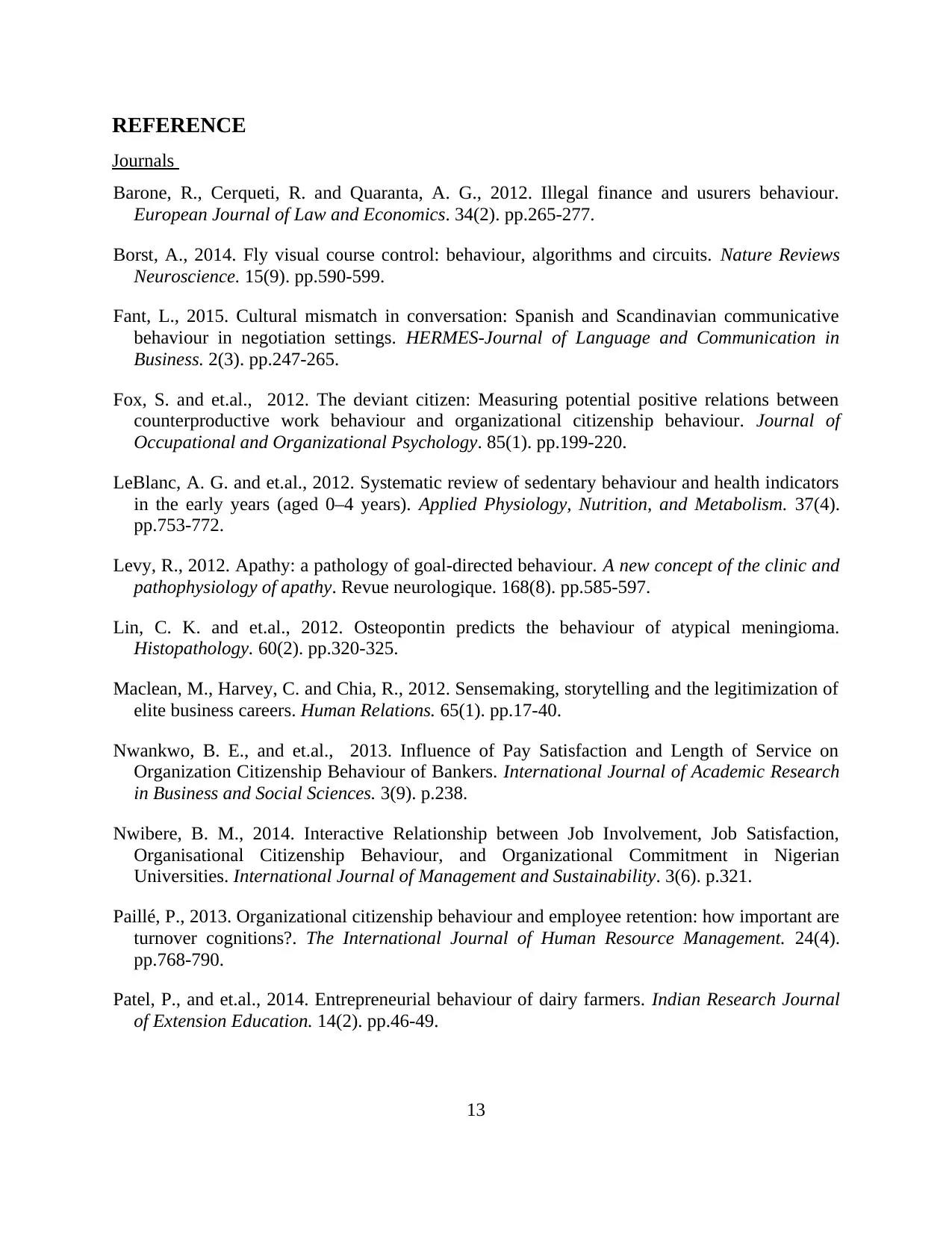
REFERENCE
Journals
Barone, R., Cerqueti, R. and Quaranta, A. G., 2012. Illegal finance and usurers behaviour.
European Journal of Law and Economics. 34(2). pp.265-277.
Borst, A., 2014. Fly visual course control: behaviour, algorithms and circuits. Nature Reviews
Neuroscience. 15(9). pp.590-599.
Fant, L., 2015. Cultural mismatch in conversation: Spanish and Scandinavian communicative
behaviour in negotiation settings. HERMES-Journal of Language and Communication in
Business. 2(3). pp.247-265.
Fox, S. and et.al., 2012. The deviant citizen: Measuring potential positive relations between
counterproductive work behaviour and organizational citizenship behaviour. Journal of
Occupational and Organizational Psychology. 85(1). pp.199-220.
LeBlanc, A. G. and et.al., 2012. Systematic review of sedentary behaviour and health indicators
in the early years (aged 0–4 years). Applied Physiology, Nutrition, and Metabolism. 37(4).
pp.753-772.
Levy, R., 2012. Apathy: a pathology of goal-directed behaviour. A new concept of the clinic and
pathophysiology of apathy. Revue neurologique. 168(8). pp.585-597.
Lin, C. K. and et.al., 2012. Osteopontin predicts the behaviour of atypical meningioma.
Histopathology. 60(2). pp.320-325.
Maclean, M., Harvey, C. and Chia, R., 2012. Sensemaking, storytelling and the legitimization of
elite business careers. Human Relations. 65(1). pp.17-40.
Nwankwo, B. E., and et.al., 2013. Influence of Pay Satisfaction and Length of Service on
Organization Citizenship Behaviour of Bankers. International Journal of Academic Research
in Business and Social Sciences. 3(9). p.238.
Nwibere, B. M., 2014. Interactive Relationship between Job Involvement, Job Satisfaction,
Organisational Citizenship Behaviour, and Organizational Commitment in Nigerian
Universities. International Journal of Management and Sustainability. 3(6). p.321.
Paillé, P., 2013. Organizational citizenship behaviour and employee retention: how important are
turnover cognitions?. The International Journal of Human Resource Management. 24(4).
pp.768-790.
Patel, P., and et.al., 2014. Entrepreneurial behaviour of dairy farmers. Indian Research Journal
of Extension Education. 14(2). pp.46-49.
13
Journals
Barone, R., Cerqueti, R. and Quaranta, A. G., 2012. Illegal finance and usurers behaviour.
European Journal of Law and Economics. 34(2). pp.265-277.
Borst, A., 2014. Fly visual course control: behaviour, algorithms and circuits. Nature Reviews
Neuroscience. 15(9). pp.590-599.
Fant, L., 2015. Cultural mismatch in conversation: Spanish and Scandinavian communicative
behaviour in negotiation settings. HERMES-Journal of Language and Communication in
Business. 2(3). pp.247-265.
Fox, S. and et.al., 2012. The deviant citizen: Measuring potential positive relations between
counterproductive work behaviour and organizational citizenship behaviour. Journal of
Occupational and Organizational Psychology. 85(1). pp.199-220.
LeBlanc, A. G. and et.al., 2012. Systematic review of sedentary behaviour and health indicators
in the early years (aged 0–4 years). Applied Physiology, Nutrition, and Metabolism. 37(4).
pp.753-772.
Levy, R., 2012. Apathy: a pathology of goal-directed behaviour. A new concept of the clinic and
pathophysiology of apathy. Revue neurologique. 168(8). pp.585-597.
Lin, C. K. and et.al., 2012. Osteopontin predicts the behaviour of atypical meningioma.
Histopathology. 60(2). pp.320-325.
Maclean, M., Harvey, C. and Chia, R., 2012. Sensemaking, storytelling and the legitimization of
elite business careers. Human Relations. 65(1). pp.17-40.
Nwankwo, B. E., and et.al., 2013. Influence of Pay Satisfaction and Length of Service on
Organization Citizenship Behaviour of Bankers. International Journal of Academic Research
in Business and Social Sciences. 3(9). p.238.
Nwibere, B. M., 2014. Interactive Relationship between Job Involvement, Job Satisfaction,
Organisational Citizenship Behaviour, and Organizational Commitment in Nigerian
Universities. International Journal of Management and Sustainability. 3(6). p.321.
Paillé, P., 2013. Organizational citizenship behaviour and employee retention: how important are
turnover cognitions?. The International Journal of Human Resource Management. 24(4).
pp.768-790.
Patel, P., and et.al., 2014. Entrepreneurial behaviour of dairy farmers. Indian Research Journal
of Extension Education. 14(2). pp.46-49.
13
Paraphrase This Document
Need a fresh take? Get an instant paraphrase of this document with our AI Paraphraser

Ranganath, C. and Ritchey, M., 2012. Two cortical systems for memory-guided behaviour.
Nature Reviews Neuroscience. 13(10). pp.713-726.
Books
Bell, W. J., 2012. Searching behaviour: the behavioural ecology of finding resources. Springer
Science & Business Media.
Child, J., 2015. Organization: contemporary principles and practice. John Wiley & Sons.
Clegg, S. and Dunkerley, D., 2013. Organization, class and control. Routledge.
Hakansson, H., 2014. Corporate Technological Behaviour (Routledge Revivals): Co-opertation
and Networks. Routledge.
Hilyard, N. C. and Cunningham, A. eds., 2012. Low density cellular plastics: physical basis of
behaviour. Springer Science & Business Media.
Ulrich, H. and Probst, G. eds., 2012. Self-organization and management of social systems:
Insights, promises, doubts, and questions. Springer Science & Business Media.
Online
Chand, S., 2015. 8 Types of Organisational Structures: their Advantages and Disadvantages.
[Online]. Available through: <http://www.yourarticlelibrary.com/organization/8-types-of-
organisational-structures-their-advantages-and-disadvantages/22143/>. [Accessed on 19th
August, 2016]
City of Westminster college. 2016. [Online]. Available through:
<http://www.cwc.ac.uk/Pages/default.aspx>. [Accessed on 19th August, 2016].
Factors Affecting Employee Behaviour. 2016. [Online]. Available through:
<http://www.managementstudyguide.com/factors-affecting-employee-behaviour.html>.
[Accessed on 19th August, 2016]
Wolski, C., 2016. Factors That Promote Effective Teamwork. [Online]. Available through:
<http://smallbusiness.chron.com/factors-promote-effective-teamwork-1932.html>.
[Accessed on 19th August, 2016].
14
Nature Reviews Neuroscience. 13(10). pp.713-726.
Books
Bell, W. J., 2012. Searching behaviour: the behavioural ecology of finding resources. Springer
Science & Business Media.
Child, J., 2015. Organization: contemporary principles and practice. John Wiley & Sons.
Clegg, S. and Dunkerley, D., 2013. Organization, class and control. Routledge.
Hakansson, H., 2014. Corporate Technological Behaviour (Routledge Revivals): Co-opertation
and Networks. Routledge.
Hilyard, N. C. and Cunningham, A. eds., 2012. Low density cellular plastics: physical basis of
behaviour. Springer Science & Business Media.
Ulrich, H. and Probst, G. eds., 2012. Self-organization and management of social systems:
Insights, promises, doubts, and questions. Springer Science & Business Media.
Online
Chand, S., 2015. 8 Types of Organisational Structures: their Advantages and Disadvantages.
[Online]. Available through: <http://www.yourarticlelibrary.com/organization/8-types-of-
organisational-structures-their-advantages-and-disadvantages/22143/>. [Accessed on 19th
August, 2016]
City of Westminster college. 2016. [Online]. Available through:
<http://www.cwc.ac.uk/Pages/default.aspx>. [Accessed on 19th August, 2016].
Factors Affecting Employee Behaviour. 2016. [Online]. Available through:
<http://www.managementstudyguide.com/factors-affecting-employee-behaviour.html>.
[Accessed on 19th August, 2016]
Wolski, C., 2016. Factors That Promote Effective Teamwork. [Online]. Available through:
<http://smallbusiness.chron.com/factors-promote-effective-teamwork-1932.html>.
[Accessed on 19th August, 2016].
14
1 out of 14
Related Documents
Your All-in-One AI-Powered Toolkit for Academic Success.
+13062052269
info@desklib.com
Available 24*7 on WhatsApp / Email
![[object Object]](/_next/static/media/star-bottom.7253800d.svg)
Unlock your academic potential
© 2024 | Zucol Services PVT LTD | All rights reserved.





